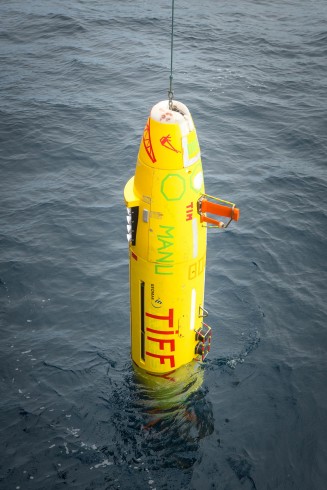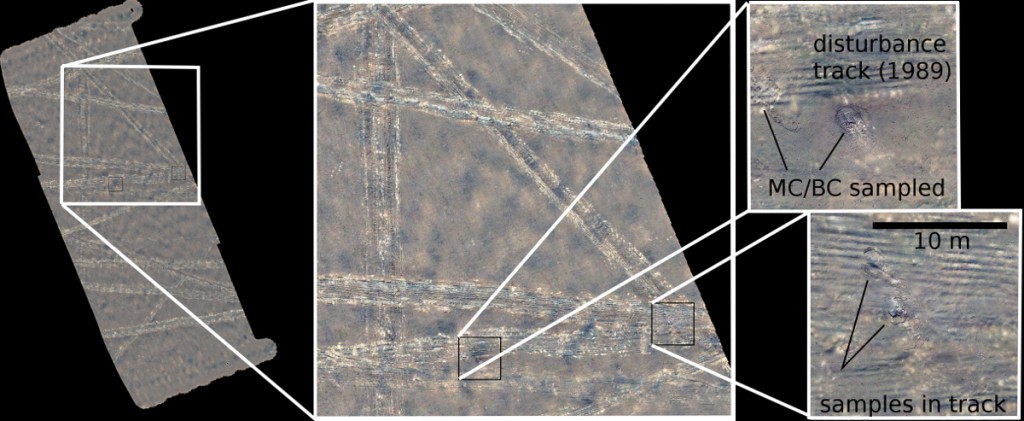by Kevin Köser
Today is already Friday, the 21st of August and the cruise is about to reach its end. Although the last 4 weeks have been quite a while, when you are busy, time flies by quickly and on Sunday we already have to steam back to Guayaquil. The ship and the gear is runnig 24/7 and during these last days everybody wants to obtain the final (extra) bits of data with “her/his” instruments in the water.
The photo surveys of the AUV (“Tiffy”) are finished and the camera system has been unmounted to give space to the subbottom profiler for the final dives. During the last weeks Tiffy has made 9 photo survey dives, among them Tiffy’s 200th dive, which was celebrated appropriately.

The AUV goes on its 200th dive. Photo by Bastian Barenbrock
During each 10h-12h dive (time at the bottom) we captured a 20 megapixel image each second, which makes up to 40000 pictures per mission. We record more photos on a single day than all previous DISCOL expeditions have captured in all years alltogether and if you would count all pixel in all images, during cruise SO-242/1 Tiffy has made the incredible number of 4 600 000 000 000 (4 trillion) optical measurements. So you might wonder who’s the poor person to evaluate all this data? Fortunately, we have computers that stitch the photographs to big maps of the seafloor, so that we dont get lost in the tons of single photographs, get a better overview and measure distances and sizes of things. I am writing the software for doing this.
In the picture at the top, you can see the 1989 disturbance tracks (after 26 years!), and also the positions where our gear like multi-corer, gravity-corer and box-corer hit the ground. Onboard we compute a quick preview mosaic and take all the image data home, where photogrammetry, annotation, classification and interpretation will go on. So, the cruise is almost over, but the work is just starting …
See you soon,
Kevin

Dear Kevin,
my 6y son asked me the other day about the temperature at the bottom of the Mariana Trench. Having studied limnoecology I quickly replied 4°C, because of the density anomaly of the water. My wife did not believe me and wikipedia’ed the question. Of course, I forgot about the phase diagram and the pressure at the bottom of the sea, let alone it’s salinity (missing in limnology). So, could you please answer my son’s question properly, taking into account the openings of the continental shelves with its lava? He is really into continents…
Thanks,
Florian
Dear Florian,
normally the temperature at the bottom of the sea is around 2°C at abyssal plains (so around 5000 m). This temperature is quite stable if you don’t have any cold seeps or hydrothermal vents around. So I would say that the
temperature also in the Mariana trench would be around 2°C. I also checked the CTD data that was done here onboard, and there the temperatures are also ~2°C.
Additionally the high pressure as well as the high salinity allow the water to have a higher density at lower temperatures than the normal state of freshwater. The salinity also decreases the freezing point so that seawater freezes only at -1.8 °C.
The so-called hydorthermal vents (or black smokers) at mid-ocean ridges can result in water temperatures of up to 400°C at the vent site itself.
However, the water cools down very fast and the energy is not enough to warm up wide areas of the seafloor. It is hard to imagine the wide area of the ocean but maybe you can compare it with one small factory producing smoke in the whole of Europe, after a few kilometers driving away from the factory you don’t see any smoke anymore.
At passive continental margins (where there is no subduction of oceanic plates) a phenomenon called cold seeps occurs where in a very small area gashydrates escape wich can also result in increased water temperatures (~40°C), but also for this phenomenon the warmth does not spread through wide areas. Interestingly, there are some animals that are specialized to live in these warm deep-sea environments and researchers are still trying to figure out how they travel between sites (through cold water) to colonize new warm sites.
Best,
Lidia and Lisa
Dear Lidia and Lisa,
thanks a lot for your answer, I never heard of the gashydrate-refuge before! I guess your answer settles the question, I am forwarding it to my wife and translate it to my son!
Cheers,
Florian